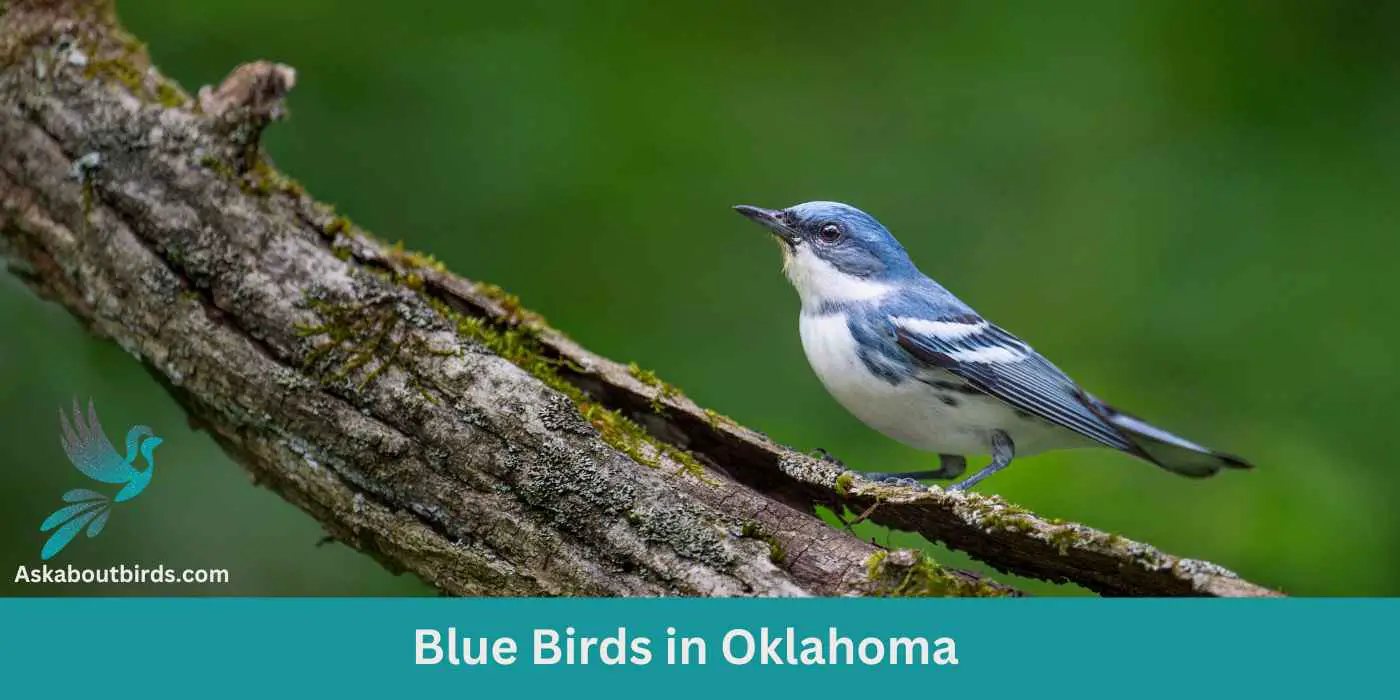Welcome to the colorful world of blue birds in Oklahoma! This guide is designed for bird enthusiasts who are keen to explore the diversity of blue birds in the heartland of America. Oklahoma, with its varied landscapes and climates, is a haven for a variety of bird species. With this free photo guide, we invite you to embark on a journey to discover, observe, and photograph the magnificent blue birds that grace the skies and landscapes of Oklahoma.
From the striking blue of the Eastern Bluebird to the iridescent shimmer of the Indigo Bunting, this guide will help you identify, locate, and capture stunning images of Oklahoma’s blue birds. So grab your binoculars, camera, and this guide, and let’s embark on an exciting birdwatching adventure together!
Blue Birds Found In Oklahoma
Oklahoma’s varied geography is a key reason for its diverse range of birds. The state encompasses a range of ecosystems, from the arid western plains to the humid eastern forests and wetlands, providing a multitude of habitats for different bird species. Additionally, Oklahoma lies at the crossroads of the Central and Mississippi Flyways, major bird migration routes, making it a critical stopover point for many migratory species. This, combined with the state’s central location in the United States, makes it a meeting point for birds from both the east and the west, resulting in a rich and diverse bird population.
Blue Jay

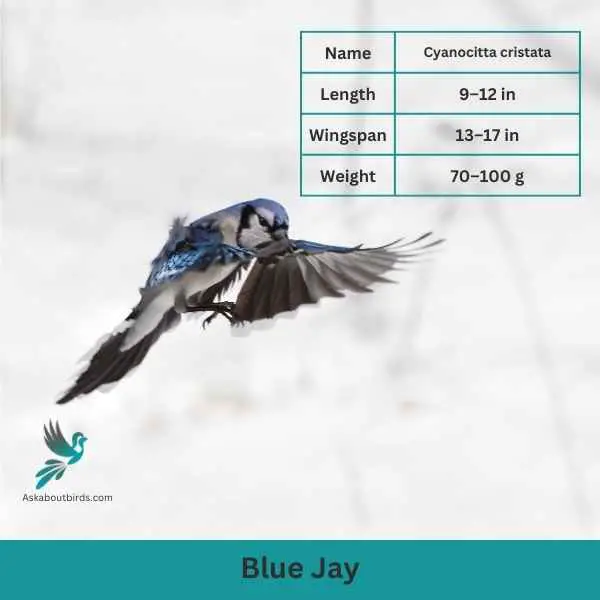
| Feature | Measurement |
|---|---|
| Scientific Name | Cyanocitta cristata |
| Length | 9–12 in |
| Wingspan | 13–17 in |
| Weight | 70–100 g |
The Blue Jay is a vibrant and easily recognized bird, known for its intelligence, distinctive calls, and bold behavior, commonly found throughout the eastern and central United States.
Appearance: The Blue Jay sports a striking blue upper body with white and black markings. Its face has a pronounced white patch with a black necklace that runs across the throat and around the head. The bird also features a pronounced blue crest, which can be raised or lowered, and its wings and tail are brightly colored with black bars and white tips.
Diet: Blue Jays are omnivores. Their diet consists primarily of seeds, nuts, especially acorns, fruits, and small insects. They’ve also been known to eat eggs or nestlings of other birds occasionally. Blue Jays often store food items in caches to eat later.
Reproduction: Blue Jays are monogamous birds that form long-lasting pair bonds. They typically build their nests in trees or large shrubs, constructing them from twigs, grass, and sometimes using mud as a binder. The female lays a clutch of 3 to 6 eggs, which are pale blue or sometimes white with brown speckles.
Barn Swallow


| Feature | Measurement |
|---|---|
| Scientific Name | Hirundo rustica |
| Length | 6.5–7.5 in |
| Wingspan | 12.5–13.5 in |
| Weight | 16–22 g |
The Barn Swallow is a sleek, agile bird renowned for its graceful flight patterns and iconic forked tail, often seen darting over fields and water bodies in search of flying insects.
Appearance: Barn Swallows have deep blue, almost iridescent, upperparts and a rufous to tawny underbelly. Their distinctively forked tail and long wings give them a streamlined look. Both males and females have a similar appearance, though males often exhibit slightly brighter colors and a deeper fork in the tail.
Diet: Barn Swallows feed primarily on flying insects, which they catch in mid-air during their agile and acrobatic flights. Their diet includes flies, beetles, moths, and other small flying insects.
Reproduction: Barn Swallows are known for building their mud nests on man-made structures, particularly barns, bridges, and eaves. The nest is cup-shaped and made from mud pellets, often lined with feathers. The female lays a clutch of 4 to 6 eggs.
Belted Kingfisher

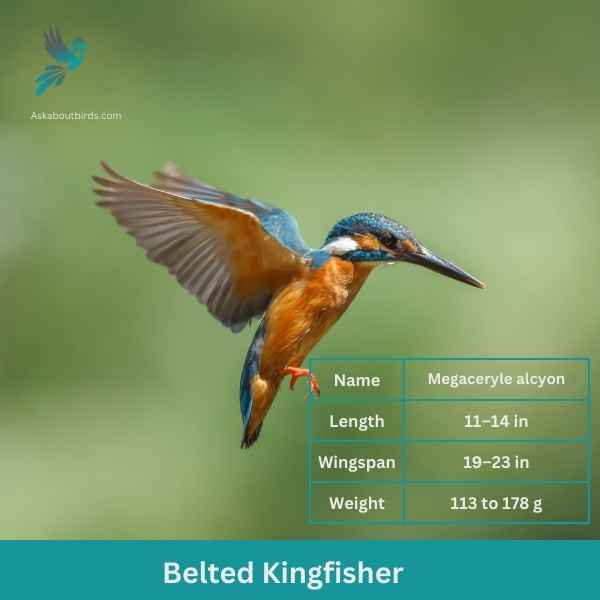
| Feature | Measurement |
|---|---|
| Scientific Name | Megaceryle alcyon |
| Length | 11–14 in |
| Wingspan | 19–23 in |
| Weight | 113 to 178 g |
The Belted Kingfisher is a distinctive and easily recognizable bird, frequently observed near water bodies, where it can be seen diving headfirst to catch prey.
Appearance: Sporting a prominent crest, the Belted Kingfisher has a slate blue-gray upper body and white underparts. Males possess a single blue band across their white chests, while females have an additional rufous band, making them one of the few bird species where females are more brightly colored than males. Their bill is long, sharp, and dagger-like.
Diet: As expert fishers, Belted Kingfishers mainly prey on small fish, but they’ll also consume crustaceans, insects, and amphibians. They’re known for their hunting tactic of hovering over water, spotting their prey, and then diving swiftly to snatch it.
Reproduction: Belted Kingfishers nest in burrows which they excavate in sandy or earthen banks, usually adjacent to water. The tunnel can be anywhere from 3 to 6 feet long, ending in a chamber. Within this chamber, the female lays a clutch of 5 to 8 white eggs.
Indigo Bunting


| Feature | Measurement |
|---|---|
| Scientific Name | Passerina cyanea |
| Length | 4.5–5.1 in |
| Wingspan | 7.1–9.1 in |
| Weight | 11.2–21.4 g |
The Indigo Bunting is a strikingly vibrant songbird, often hailed for its brilliant blue plumage and melodic song that graces woodlands and meadows during the warmer months.
Appearance: Males are renowned for their bright indigo blue feathers, which can appear darker in certain lights. Females and juveniles, on the other hand, are brown with subtle hints of blue on their wings and tail. The species lacks the vibrant streaking or spotting commonly found in many other songbirds.
Diet: Indigo Buntings primarily subsist on seeds, especially during non-breeding seasons. During the breeding season, they also consume a variety of insects such as beetles, caterpillars, and spiders, providing essential protein for their growing chicks.
Reproduction: Indigo Buntings build their nests close to the ground in shrubs or low tree branches. These nests, crafted meticulously with grasses and other plant materials, cradle clutches of typically 3 to 4 eggs. After hatching, the young are fed by both parents until they’re ready to fledge.
Purple Martin
Scientific Name: Progne subis
Length: 7.5-9.1 in (19-23 cm)
Wingspan: 15.3-16.1 in (39-41 cm)
Weight: 1.9-2.3 oz (55-65 g)
The Purple Martin is a popular and widely recognized bird species, known for its acrobatic flight and social behavior.
Appearance: Purple Martins have a dark, glossy purple-blue plumage. Males are almost entirely dark purple while females and young birds have a lighter, greyish belly and throat.
Diet: The diet of Purple Martins primarily consists of flying insects such as beetles, flies, dragonflies, and moths. They catch their prey in mid-air while flying.
Reproduction: Purple Martins nest in colonies, often using artificial nest boxes provided by humans. The female typically lays a clutch of 4 to 6 white eggs, and both parents participate in incubating the eggs and feeding the chicks.
Tree Swallow
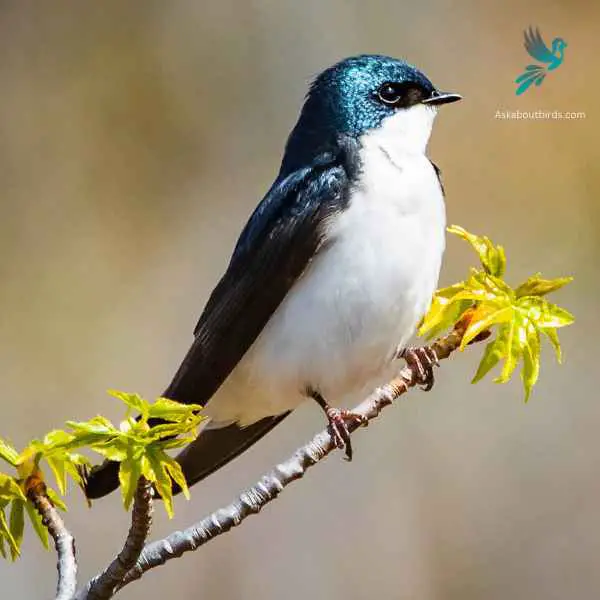
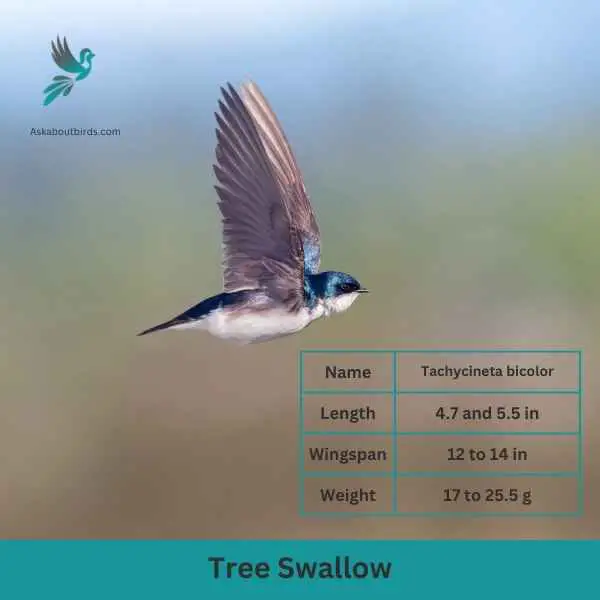
| Feature | Measurement |
|---|---|
| Scientific Name | Tachycineta bicolor |
| Length | 4.7 and 5.5 in |
| Wingspan | 12 to 14 in |
| Weight | 17 to 25.5 g |
The Tree Swallow is a graceful and agile bird, best recognized for its iridescent blue-green upperparts and sweeping flight patterns over open fields and water.
Appearance: The Tree Swallow is sleek with a streamlined body. The upperparts shine with a blue-green iridescence while the underparts are white. They possess long, pointed wings and a slightly forked tail, aiding in their agile flight.
Diet: Tree Swallows primarily feed on flying insects, skillfully catching them mid-air. During colder months when insects are scarce, they can switch to a diet of berries, particularly those of the bayberry, which other birds might find hard to digest.
Reproduction: Tree Swallows are cavity-nesters, typically choosing natural holes in trees or using bird boxes. They line their nests with feathers, creating a soft environment for the eggs. The female will lay a clutch of 4 to 7 white eggs.
Blue Grosbeak
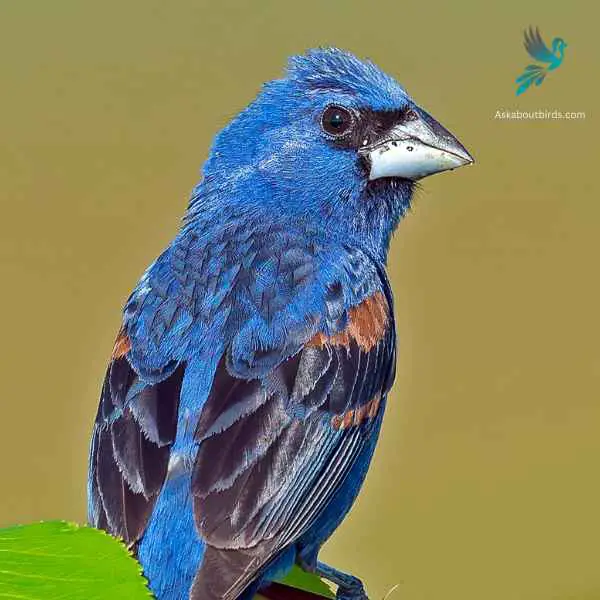

| Feature | Measurement |
|---|---|
| Scientific Name | Passerina caerulea |
| Length | 5.5 to 7.5 in |
| Wingspan | 10 to 11 in |
| Weight | 26 to 31.5 g |
The Blue Grosbeak is a medium-sized songbird found in North and Central America. The male Blue Grosbeak displays stunning plumage with deep blue feathers on its body and head, while the female has more subdued brownish tones. Both sexes have a thick, conical bill, which gives them their name “grosbeak,” meaning large beak.
These birds prefer open habitats such as grasslands, brushy areas, and woodland edges. Blue Grosbeaks are known for their melodious songs, which consist of a series of rich and varied notes. They primarily feed on seeds and insects, using their strong beaks to crack open seeds and forage on the ground or in low vegetation.
Eastern Bluebird
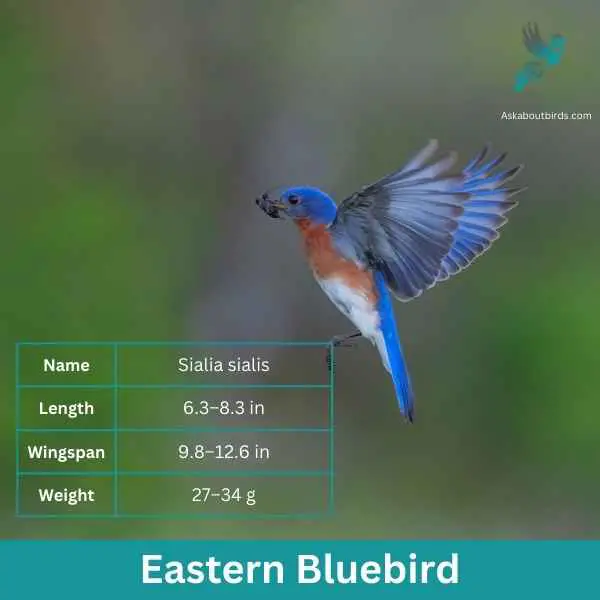
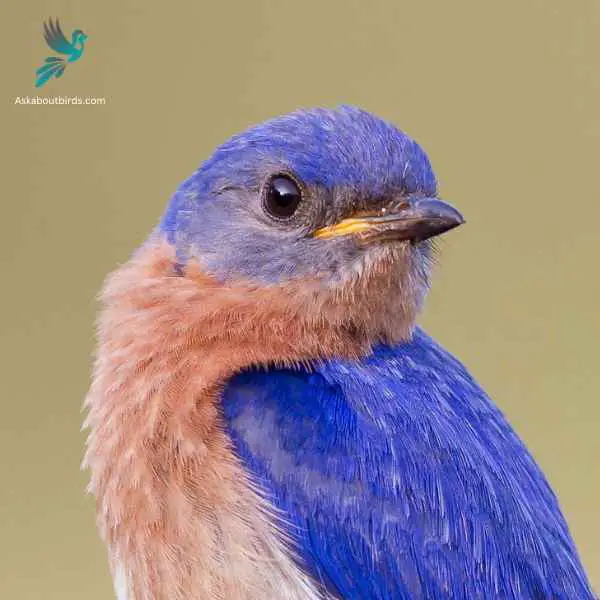
| Feature | Measurement |
|---|---|
| Scientific Name | Sialia sialis |
| Length | 6.3–8.3 in |
| Wingspan | 9.8–12.6 in |
| Weight | 27–34 g |
The Eastern Bluebird (Sialia sialis) is a small thrush found in open woodlands, farmlands, and orchards, and is recognized for its vibrant blue and red coloration. Male Eastern Bluebirds are dazzling with bright blue upperparts and a rusty or brick-red throat and breast, while females, though less colorful, still offer a similar pattern. The bird is native to North America and is commonly seen east of the Rockies, from Canada to the Gulf States and southeastern Arizona to Nicaragua.
Eastern Bluebirds feed on insects, wild fruit and berries. They have a gentle nature and are often seen perched alone or in small groups in the open, scanning the ground for prey. They are cavity nesters and will use old woodpecker holes or birdhouses if they are the right size.
Cerulean Warbler
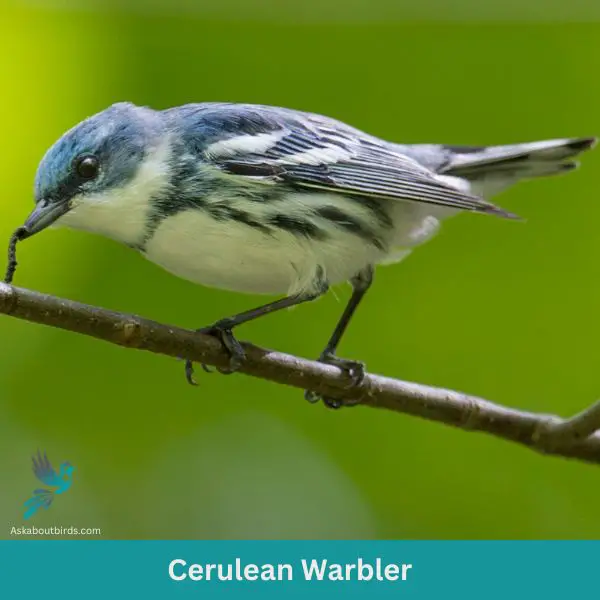
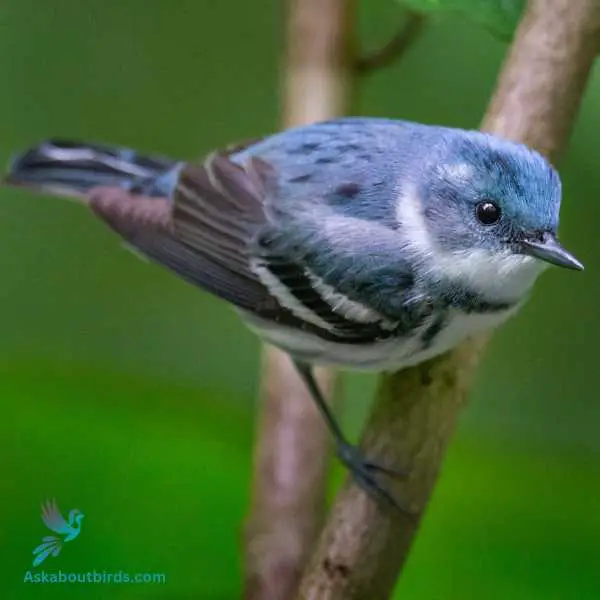
| Trait | Cerulean Warbler |
|---|---|
| Scientific Name | Setophaga cerulea |
| Length | 4.5 inches |
| Wingspan | 7.9-8.7 inches |
| Weight | 0.3-0.4 ounces |
The Cerulean Warbler is a striking songbird known for its sky-blue plumage and flitting movements in the forest canopy.
Appearance: Males boast a vibrant cerulean blue color on their upperparts, with streaked underparts, and a black necklace. Females have a more subdued bluish-green hue and lack the prominent black markings seen in males.
Diet: The diet of the Cerulean Warbler is predominantly made up of insects and spiders. They actively forage high in the treetops, gracefully maneuvering through leaves and branches.
Reproduction: Cerulean Warblers nest in the upper branches of tall deciduous trees. The female weaves a shallow cup-shaped nest and lays a clutch of 3-5 eggs.
Mountain Bluebird
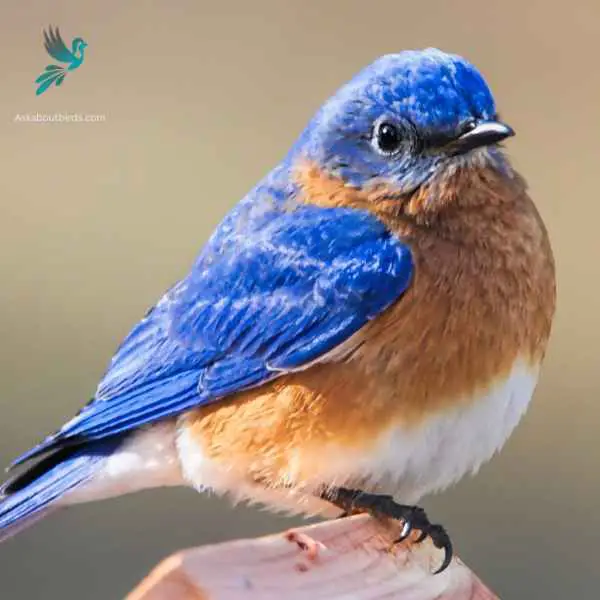
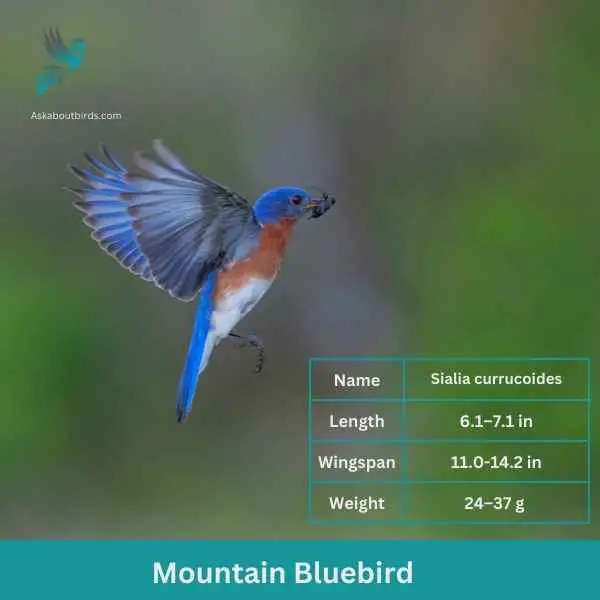
| Feature | Measurement |
|---|---|
| Scientific Name | Sialia currucoides |
| Length | 6.1–7.1 in |
| Wingspan | 11.0-14.2 in |
| Weight | 24–37 g |
The Mountain Bluebird is a small bird found in open grasslands and rocky mountains of North America. It is known for its stunning blue plumage, which is particularly vibrant in males. Females, on the other hand, have a more subdued blue coloration with hints of gray. These birds have slender bodies and a slightly curved bill, adapted for catching insects on the wing.
Mountain Bluebirds are insectivores, feeding primarily on insects such as beetles, grasshoppers, and spiders. They are skilled aerial hunters, capable of capturing their prey in mid-flight. During breeding season, these birds build their nests in tree cavities or man-made nest boxes, where females lay a clutch of eggs. The male bluebird actively participates in nest-building and provides food for the female during incubation.
Lazuli Bunting
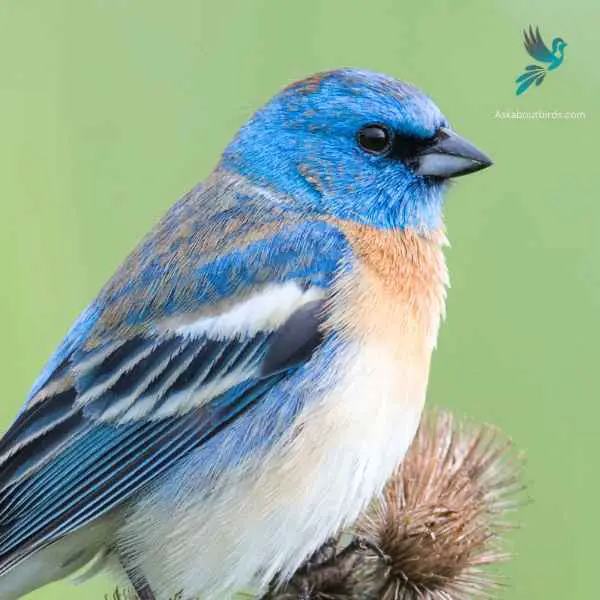

| Feature | Measurement |
|---|---|
| Scientific Name | Passerina amoena |
| Length | 5.1-5.9 in |
| Wingspan | 8.7 in |
| Weight | 13-18 g |
The Lazuli Bunting is a vibrant songbird recognized for its brilliant colors and melodious song, frequently seen in brushy areas and woodlands during the summer months.
Appearance: The male boasts a dazzling bright blue head and back, offset by a white belly and rust-orange breast. Females and immature birds present a more muted brownish hue overall, with a hint of blue on the wings and tail.
Diet: Lazuli Buntings primarily feed on seeds, but during the breeding season, they’ll also consume insects. Their strong, conical beaks are perfectly adapted for seed-cracking.
Reproduction: The female Lazuli Bunting constructs a cup-shaped nest using grasses, twigs, and other fine materials, often placing it in a shrub or low tree. She typically lays a clutch of 3-4 pale blue or white eggs.
Woodhouse’s Scrub-Jay
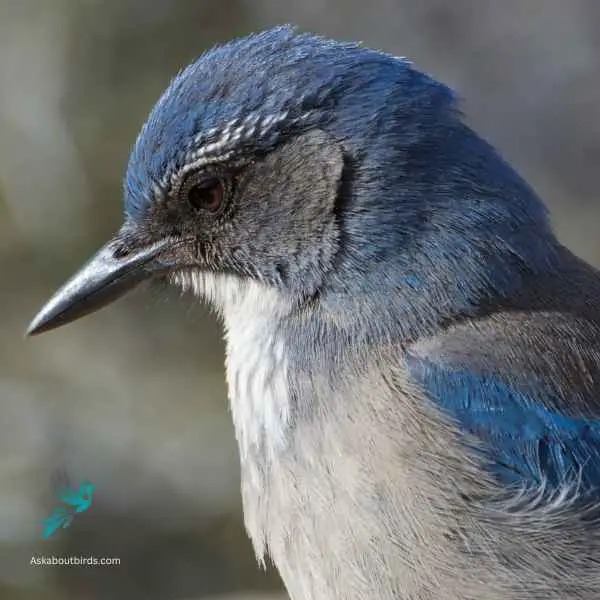

| Feature | Measurement |
|---|---|
| Scientific Name | Aphelocoma woodhouseii |
| Length | 11–12 in |
| Wingspan | 15 in |
| Weight | 80 g |
Woodhouse’s Scrub-Jay is a medium-sized bird that is found in the western part of North America. It has a blue-gray head, wings, and tail, with a brownish-gray back and a white belly. The bird’s bill is black and its eyes are dark. Woodhouse’s Scrub-Jay is known for its loud and harsh calls, which it uses to communicate with other birds in its flock.
This bird is commonly found in arid and semi-arid habitats, such as deserts, scrublands, and oak woodlands. It is an omnivore, feeding on a variety of insects, seeds, fruits, and small animals. Woodhouse’s Scrub-Jay is known for its intelligence and ability to cache food for later use. It is also a territorial bird, defending its territory from other birds and animals. Despite being a common bird, Woodhouse’s Scrub-Jay is threatened by habitat loss and fragmentation, making conservation efforts important for its survival.
Blue-winged Warbler
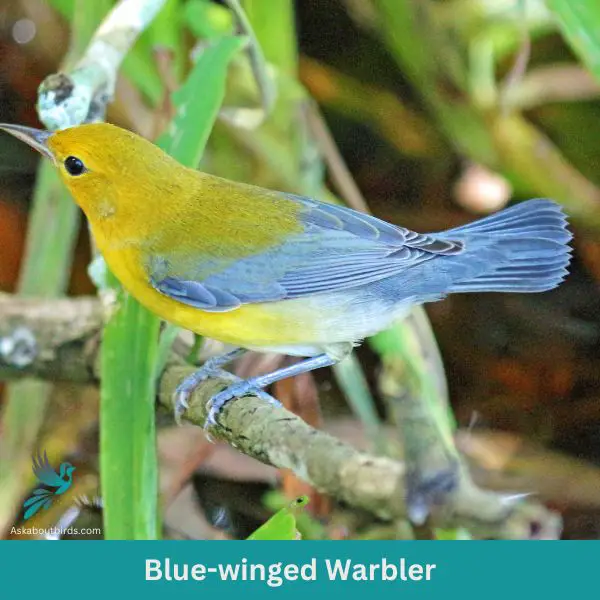
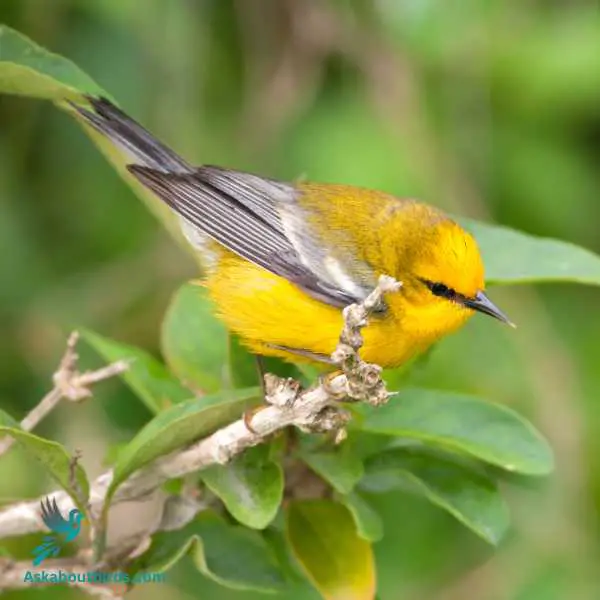
| Trait | Blue-winged Warbler |
|---|---|
| Scientific Name | Vermivora cyanoptera |
| Length | 4.3-4.7 inches |
| Wingspan | 6.7-7.5 inches |
| Weight | 0.3-0.4 ounces |
The Blue-winged Warbler is a vibrant songbird that stands out with its lemon-yellow coloring and buzzing song.
Appearance: This warbler displays a brilliant yellow body contrasted by blue-gray wings and a slim, black line through the eyes. The wings also feature two white wing bars.
Diet: The diet of the Blue-winged Warbler primarily consists of insects and spiders. They actively forage in shrubs and low trees, picking off their prey from the foliage.
Reproduction: Blue-winged Warblers build their nests on or near the ground, using grasses and other fine materials. The female lays a clutch of 4-6 eggs, which she incubates.
Blue-gray Gnatcatcher
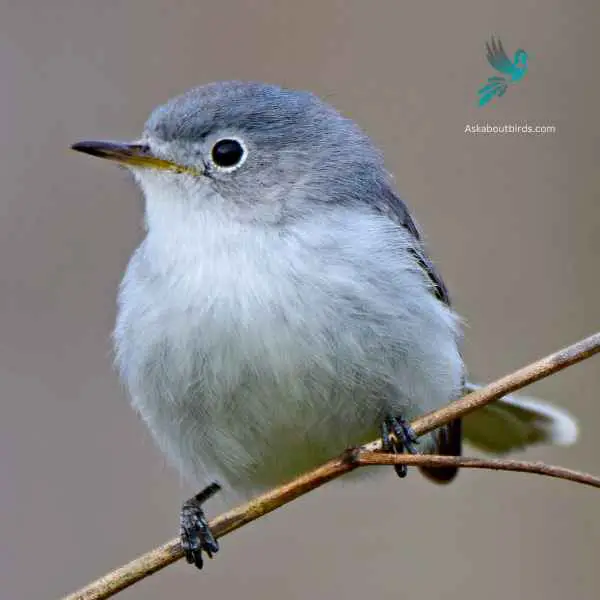
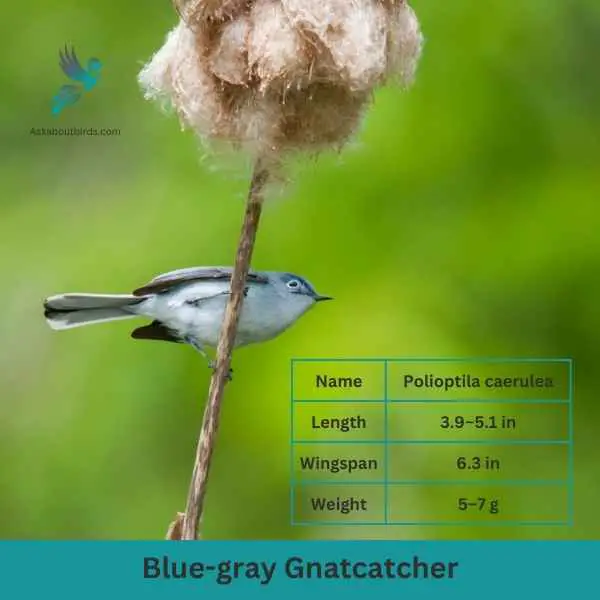
| Feature | Measurement |
|---|---|
| Scientific Name | Polioptila caerulea |
| Length | 3.9–5.1 in |
| Wingspan | 6.3 in |
| Weight | 5–7 g |
The Blue-gray Gnatcatcher is a petite, active bird, frequently observed flitting about treetops, emitting its distinctive high-pitched calls as it moves agilely through the branches.
Appearance: This bird exhibits a predominantly blue-gray plumage with a subtle white eye ring and long, slender tail feathers. The tail has distinctive black and white edging, with the males sometimes showing a faint black line on their forehead during the breeding season.
Diet: Blue-gray Gnatcatchers primarily feed on small insects and spiders. They’re adept hunters, foraging actively among foliage and even catching insects in mid-air.
Reproduction: These birds weave compact, cup-shaped nests on tree branches using plant materials, spider webs, and lichen. The exterior of the nest often matches the tree bark, making it well camouflaged. Inside, the female lays a clutch of 3 to 5 blue or greenish eggs, which she incubates.
Red-breasted Nuthatch

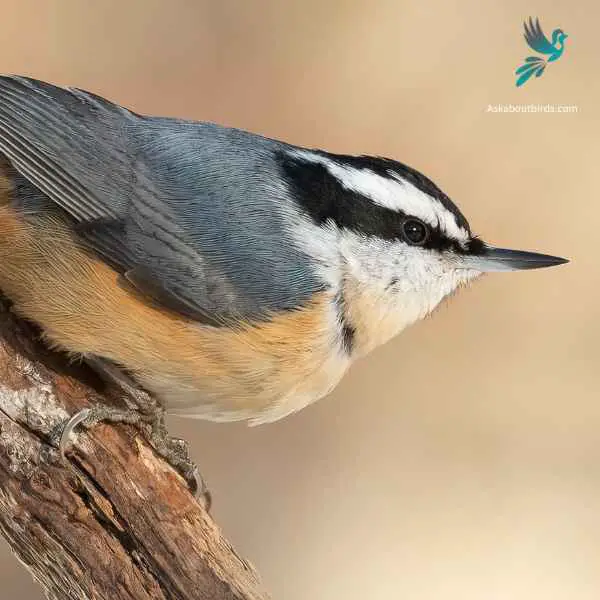
| Feature | Measurement |
|---|---|
| Scientific Name | Sitta canadensis |
| Length | 4.3–4.7 in |
| Wingspan | 8.3 in |
| Weight | 0.3–0.5 oz |
The Red-breasted Nuthatch is a small, agile songbird, known for its ability to move headfirst down tree trunks while searching for food.
Appearance: This bird boasts a slate-blue back and a pale rust-red underside. A prominent black stripe runs through the eye and is bordered above by a white eyebrow. Their sharp, pointed bill is characteristic of the species.
Diet: Red-breasted Nuthatches primarily feed on insects and seeds, especially those from coniferous trees. They have a fondness for large seeds, which they wedge into bark crevices to hack open with their bills.
Reproduction: These birds construct nests in natural tree cavities or abandoned woodpecker holes, often lining the entrance with resin. This is thought to deter predators or competitors from entering. The female typically lays a clutch of 5 to 6 eggs, and both parents partake in feeding the chicks once they hatch.
Where to Spot Oklahoma’s Blue Birds
Oklahoma is a hidden gem for birdwatchers, particularly for those with a keen interest in blue birds. From the cypress-filled wetlands in the east to the high plains and mesas in the west, the state offers a wide variety of habitats that attract a diverse range of bird species. Here are some of the top locations in Oklahoma known for the greatest diversity of birds:
- Wichita Mountains Wildlife Refuge: This refuge in southwestern Oklahoma is home to more than 240 bird species, including a variety of blue birds. The rugged landscape of mountains, forests, and prairies provides a perfect habitat for them.
- Sequoyah National Wildlife Refuge: Located in the eastern part of the state, this refuge is a haven for waterfowl and wading birds. The mix of wetlands, forests, and grasslands attract a wide variety of bird species, including several species of blue birds.
- Salt Plains National Wildlife Refuge: Situated in north-central Oklahoma, the Salt Plains are a unique habitat that attracts many bird species not commonly seen elsewhere in the state. The saline flatlands and salt-encrusted plains are perfect for spotting a variety of blue birds.
- Oxley Nature Center: Located in Tulsa, the Oxley Nature Center offers a mix of marshes, forests, and prairies that provide habitat for a wide range of bird species, making it a great spot for birdwatching year-round.
- Red Slough Wildlife Management Area: This southeastern Oklahoma site offers a mix of wetlands, forests, and agricultural fields that attract a wide variety of bird species, including many species of blue birds.
| Neighboring States | Best Spots for Blue Birds |
|---|---|
| Kansas’s Blue birds | 1. Quivira National Wildlife Refuge 2. Cheyenne Bottoms 3. Flint Hills |
| Arkansas’s Blue birds | 1. Buffalo National River 2. Holla Bend National Wildlife Refuge 3. Mount Magazine State Park |
| Missouri’s Blue birds | 1. Mingo National Wildlife Refuge 2. Riverlands Migratory Bird Sanctuary 3. Mark Twain National Forest |
| Colorado’s Blue birds | 1. Rocky Mountain National Park 2. Pawnee National Grassland 3. Comanche National Grassland |
| Texas’s Blue birds | 1. Big Bend National Park 2. Brazos Bend State Park 3. Aransas National Wildlife Refuge |
| New Mexico’s Blue birds | 1. Bosque del Apache National Wildlife Refuge 2. Ruidoso 3. Gila National Forest |
FAQs on Blue Bird Species Found in Oklahoma
How can I protect bluebird houses from house sparrows and european starlings?
It’s essential to actively protect bluebird houses from invasive species like house sparrows and European starlings. First, make sure the entrance hole is the correct size. A hole with a diameter of 1.5 inches will allow bluebirds to enter while excluding larger birds like starlings. Next, regularly monitor the nest box to ensure no invasive species have taken over. If you find a house sparrow or starling nest, remove it immediately. Installing a sparrow spooker, a device designed to deter house sparrows, can also be helpful.
What are the best places to install bluebird boxes?
Bluebird boxes should be installed in open areas with scattered trees or on the edge of a woodland. Avoid placing boxes in densely wooded areas or in the middle of large open fields without any trees nearby. Bluebirds prefer areas with a mix of open space for foraging and trees for perching. Install the box on a pole or a fence post about 4-6 feet above the ground. Make sure to tilt the box slightly forward to prevent rain from getting inside and to place it facing away from prevailing winds.
What are the key differences between bluebird species?
There are three species of bluebirds found in North America: Eastern Bluebirds, Western Bluebirds, and Mountain Bluebirds. Eastern Bluebirds have a bright blue plumage on their head, back, and wings, a rusty-orange chest, and a white belly. They are found in the eastern half of North America. Western Bluebirds have a bluish-gray head and back, bright blue wings and tail, and a rusty chest. They are found in the western regions of North America. Mountain Bluebirds have a pale blue plumage all over, and they are found in the western mountain regions.
What types of food should I provide in bird feeders during winter?
During winter, it’s essential to provide food that is high in fat and calories to help birds maintain their energy levels. Black oil sunflower seeds are an excellent choice as they are high in fat and loved by many bird species. Suet, a solid fat rendered from beef or vegetables, is also a good option, as it provides a lot of energy. Other good options include peanuts, white proso millet, and cracked corn. Remember to provide a source of unfrozen water as well.

